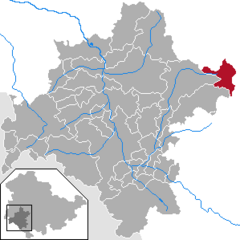Oberhof, Germany
Located in the Thuringian Forest mountain range, it is a winter sports center and health resort.
With the completion of the Brandleite Tunnel of the Neudietendorf-Ritschenhausen railway, Oberhof received a railroad connection in 1884, which enabled the expansion of tourism.
In 1931, world championships were held in the town for the first time, in two-man bobsleigh and Nordic combined on the Hindenburg ski jump.
From 1968 to 1978, Oberhof was expanded and reconstructed with extensive demolition of the existing building fabric, which completely changed the character of the place.
Walter Ulbricht, the chairman of the Council of State, called in his Berlin architect Hermann Henselmann for the planning.
Several rivers also rise near Oberhof, the Gera in the east, the Ohra in the north, the Hasel in the south and the Schönau in the west.
Unlike the other villages of the Thuringian Forest, Oberhof is located unprotected to the north, west and east on a plateau.
[1] Like many low mountain regions dependent on winter sports, Oberhof is also affected by the effects of climate change.


